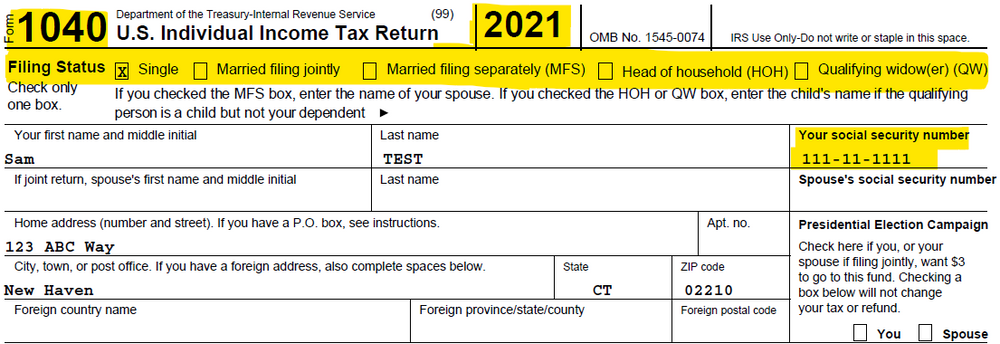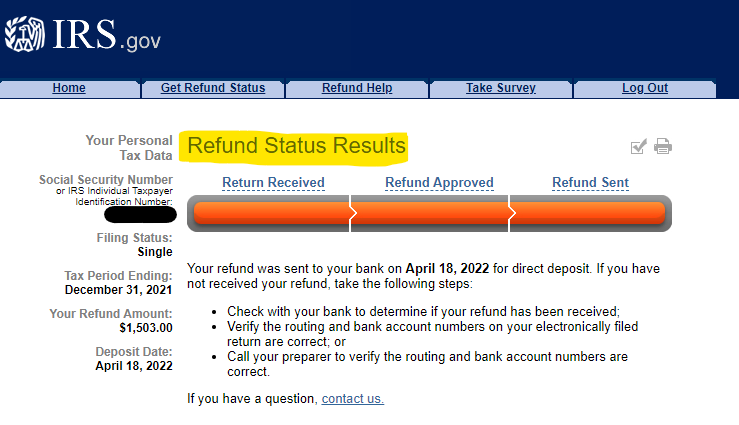Where is my Federal Tax Refund?
Your Federal tax return has been filed and you are expecting a refund. Now what? Taxpayers can easily check the status of a Federal tax return using the IRS's Where's My Refund tool. For current year tax returns that have been e-filed, typically information will be available as early as 24 hours AFTER the return has been e-filed. Keep in mind that the date the e-file authorization form is signed is not necessarily the date the return is e-filed and processed through the IRS system. Tax preparers have processes that need to be followed which means it may be a day or two before a return is actually e-filed and then the IRS has its own set of processes that the e-filed return must go through.
If a prior year tax return has been e-filed, it could take several days before the return information is available in the IRS system. If a return has been paper filed, because of IRS backlogs, it could take several months before a paper-filed return is entered into the IRS system.
To use the tool, the tax return that was filed will need to be accessible to get certain information that will be requested. Remember, this tool will only show information about returns for which a refund is to be issued.
Many states also have a similar tool to check the status of a refund. To find out if a state has a refund tool, do an online search for "where's my refund" followed by the name of the state. If the state has a refund tool available, it will usually show up in the first few results.
This article provides the information needed to use the IRS's Where's My Refund tool.
If a prior year tax return has been e-filed, it could take several days before the return information is available in the IRS system. If a return has been paper filed, because of IRS backlogs, it could take several months before a paper-filed return is entered into the IRS system.
To use the tool, the tax return that was filed will need to be accessible to get certain information that will be requested. Remember, this tool will only show information about returns for which a refund is to be issued.
Many states also have a similar tool to check the status of a refund. To find out if a state has a refund tool, do an online search for "where's my refund" followed by the name of the state. If the state has a refund tool available, it will usually show up in the first few results.
This article provides the information needed to use the IRS's Where's My Refund tool.
-
1Video Segment
-
2Check Your Refund StatusThe first step is to go to the IRS's Where's My Refund website. You will need a copy of the reference tax return that was filed to fill in key pieces of information so the IRS can cross-reference it and pull up the correct status information.
IMPORTANT: The information entered into the Where's My Refund tool must be exactly how it was reported on the reference tax return. If a name or address has changed since the return was filed and the new name/address is entered, the IRS will not recognize that information since it was not reported on the reference tax return.
Tax Year
Select the tax year for which the refund status is being checked. The tax year is shown at the top of page 1 of the 1040 individual tax return.Taxpayer Social Security Number
For taxpayers who have the filing status married filing joint, this could be either the primary taxpayer's or spouse's SSN.Filing Status
The filing status is a checkbox at the top of page 1 of the 1040 tax return and indicates whether the taxpayer(s) listed on the return filed single (S), married filing jointly (MFJ), married filing separately (MFS), head of household (HOH), or as a qualifying widower (QW).- If the filing status has changed since the filing of the return (i.e., going from single to MFJ), the filing status entered must be what is shown on the reference tax return.
Refund Amount
The refund amount entered must be an exact match in whole dollars to what was reported on the reference tax return.- The refund amount is shown on page 2 of the 1040 at line 35a

Status Results
Once the taxpayer refund information has been entered and submitted, the system will come back with a message based on what was entered. There are various messages that might display depending on the circumstances.- Refund information not found - The information may have been entered incorrectly, should be verified against the reference tax return, and re-entered.
- After re-entering the information, if the refund information is not found again, it's possible that the return has not made it into the IRS system yet.
- Wait a day or two and try again.
- It may be necessary to check with the tax filer to verify that the return was e-filed and when.
- Tax return received - This message will show that the tax return has been received by the IRS and will start processing it.
- Tax return in process - This message will show that the tax return is currently being processed by the IRS. The refund has not yet been approved and issued.
- Refund Approved - This message reflects that the return was processed and the refund approved, however, does not necessarily mean the refund has been issued.
- Refund Sent - This status reflects that the refund has been approved and has been sent via either paper check or direct deposit (DD) into a bank account as indicated on the tax return
- This status message will show the amount of the refund, when the refund was sent out, and via which method (check or DD).

-
3What Happens Once My Return is E-filed?Haven't you always wondered what happens behind the scenes once your CPA submits your e-efiled tax return? Once GO CPA has sent your tax return on to the IRS, it is basically out of our control. The IRS will process returns according to their procedures and system capabilities.
When a tax return is completed in the tax software, the software assembles a set of data files that is submitted to the IRS. Once it lands in the IRS's system, those data files are validated and processed through their system. Depending on the time of year, it could be a matter of minutes, hours, or sometimes even days. When the e-file is submitted during high-volume deadline times, validation and processing will presumably take longer.
Because of this processing time, when a return is going to be efiled we recommend waiting about 72 hours after you have received your copy of the tax return to check on your refund using the IRS's refund tool.
For paper-filed returns, the processing time is manual and will take considerably longer. Since COVID started, the IRS has been extremely backlogged with paper filed returns, among other things. They have been getting caught up, but there is still a long processing delay for anything being filed on paper. The delay could be anywhere from 6 to 8 weeks, or longer.
-
4Where's My Refund...Really, where is it?Although the IRS reports that it will issue refunds in less than 21 days for e-filed tax returns, that is not always the case. Remember, once the return is e-filed GO CPA is not able to check on the progress of a return. If the processing your return is delayed, this shouldn't be cause for alarm. It is common and there are many reasons a return could be held up in processing, including simple processing errors such as a spelling mismatch, an issue with the address, or an issue with a dependent. New items such as the child tax credit or recovery rebate credit can also cause processing delays.
In most cases, the IRS will send out a letter letting the taxpayer know the processing of their return has been delayed and explain why. Often, the IRS simply needs additional information which they will request in the letter they send out. Once they have all the information they need, the tax return will be processed and refund issued.
If you have not received your refund, do not see an update on the Where's My Refund website, and have not received a letter from the IRS explaining why, it may be time to contact them and inquire about your return. Call the IRS 1040 hotline at 800-829-1040 to speak to an IRS agent.
The IRS also has an online refund Q&A page with additional information you may find helpful
Did this answer your question?
If you still have a question, we’re here to help. Contact us

